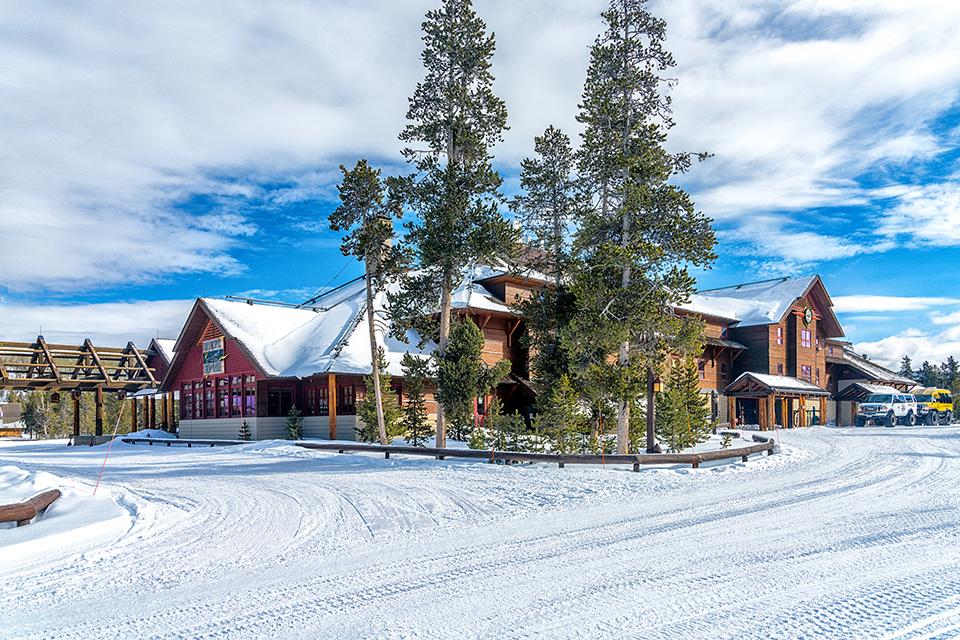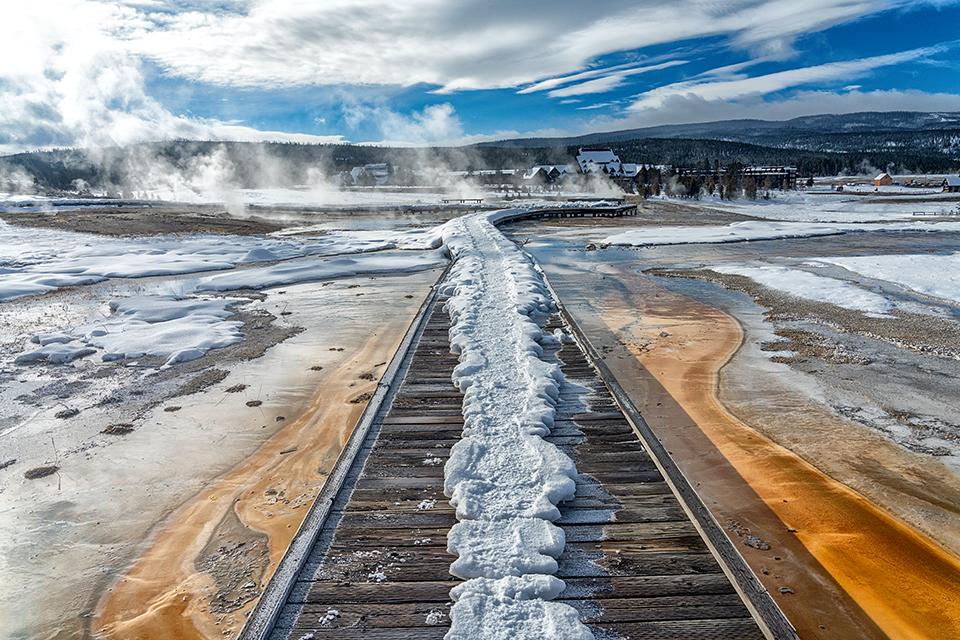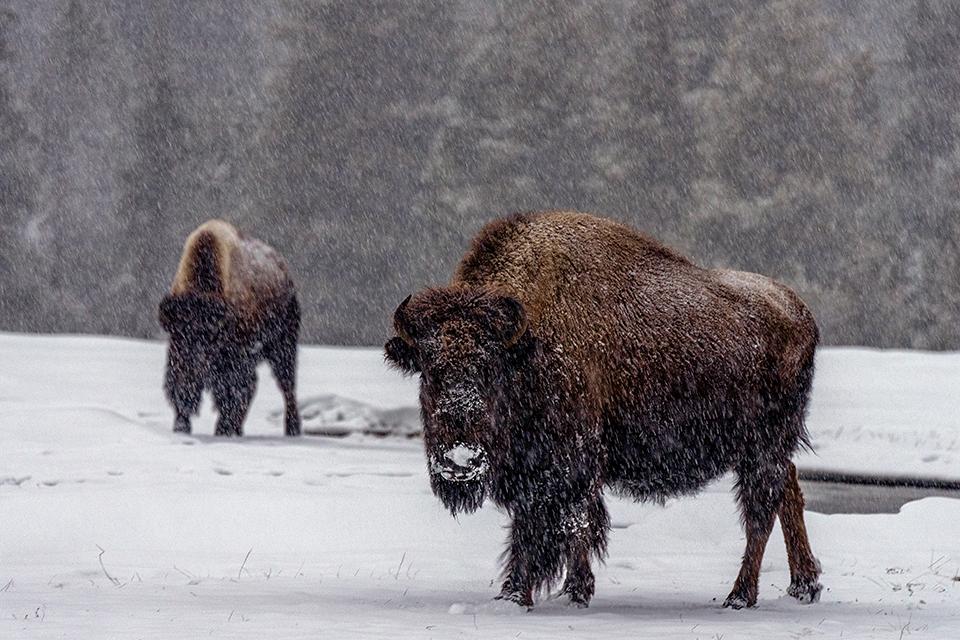
A quiet winter morning at Upper Geyser Basin, Yellowstone National Park / Rebecca Latson
Visiting Yellowstone National Park in winter is a wondrous experience with far fewer crowds than any other time of year and plenty to see and do. Snow and cold temperatures really change the character of this national park to reveal yet another side of Yellowstone’s multifaceted personality.
If you’ve read the Traveler’s Checklist for Yellowstone, you’ll have an idea of what to bring and how to prepare for a visit to America’s first national park during spring, summer, or fall. If you are thinking of a winter trip, however, there are a few more considerations for which to plan, and this Yellowstone winter checklist should help you with those plans.
Getting There

Basic map of the northern portion of the Yellowstone area / Google Maps
You can drive to the park in your own vehicle, but most of you may instead opt to fly into Bozeman, Montana, then rent a vehicle and drive 93 miles to Gardiner or 91 miles to West Yellowstone. It takes approximately two hours to drive to either town. If you don’t feel like driving at all, a daily shuttle into the park from the Bozeman Yellowstone International Airport is available during the winter.
With the exception of the road between the north and northeast entrances to the park, the other routes are closed to personal vehicles and accessible only by snowcoach, snowmobile, skis or snowshoes. To see the park interior, you’ll either need to reserve a room at the Old Faithful Snow Lodge or take a daily tour into the park via snowcoach from Mammoth or via snowmobile or snowcoach from West Yellowstone.
Staying There

Old Faithful Snow Lodge, Yellowstone National Park / Rebecca Latson
Brick-and-mortar winter accommodations in Yellowstone consist of Old Faithful Snow Lodge and Mammoth Hot Springs Hotel. Access to Old Faithful Snow Lodge is via snowcoach, for which you must reserve a seat. Except for service dogs, pets are not allowed on snowcoaches. Bear in mind, in-park lodging is pricey. Depending upon the date of your winter stay, you might be paying almost (or even over) $300/night for a room. Less expensive lodging in the form of hotels and vacation rentals may be found outside the park in Gardiner, West Yellowstone, and Cooke City (near the northeastern entrance). Nowadays, it’s a good idea to reserve your room far ahead of your anticipated stay.
If you choose to bring a trailer, RV, or brave the elements with a tent, Mammoth Campground just outside of Mammoth Hot Springs (five miles south of the north entrance) is the only open campground.
Eating There
If you stay at either of the lodgings within the park and feel like a sit-down dinner in their restaurants, you must make reservations. You might be able to snag a table as a walk-in, but don’t count on it. If you don’t feel like a sit-down dinner, you can pack into your luggage the makings for sandwiches, as the rooms have mini-fridges to keep those cold cuts and condiments fresh. At Mammoth, there’s a small general store and the town of Gardiner is only five miles north. At the Old Faithful Snow Lodge, in addition to the dining room, the Geyser Grill is open for dine-in or take-out from 11 a.m. to 3 p.m. (be warned: it gets slammed between 11:30 a.m. to 12:30 p.m.).
What To Pack
- As of this publication date, pandemic precautions are still followed within the park. The National Park Service requires facemasks to be worn inside all buildings. Perhaps, by the time you visit the park, there won't be any mask requirement. If there is, though, pack several masks and please keep track of them.

Facemask beside Crested Pool at Upper Geyser Basin: a new kind of trash, Yellowstone National Park / Rebecca Latson
- It’s incredibly dry and cold in Yellowstone during winter. Temperatures range from 20 to -20 (Fahrenheit) or even lower. Brrr! To avoid raw hands and lips, remember to pack lip balm and hand lotion.
- For winter weather, dress in layers. Pack insulated, waterproof or water-resistant pants (ski pants or fleece-lined pants), fleece tops, base layers, neck gaiters, hats that cover your ears, gloves, warm socks, insulated boots with good tread, and a waterproof insulated jacket or vest. Boot gaiters also come in handy to keep snow from sneaking inside your boots.

Packed ice and snow on the boardwalk at Upper Geyser Basin, Yellowstone National Park / Rebecca Latson
- Boot traction devices are a must for maneuvering over the thick ice- and snow-packed boardwalks and trails. Kahtoola microspikes (my personal favorite) and Yaktrax are two popular brands that slip over the soles of your boots. Just remember to remove them before stepping inside the lodges, because those cleats, spikes, or grips can chew up the floors.
- Don’t forget extra batteries and battery chargers for your cameras and smartphones. Nothing sucks the life out of a battery faster than freezing weather. Smartphones are especially vulnerable, so carry your phone in a pocket, take it out long enough for that photo or video, then place it back in your pocket to prolong battery power.
- Photographers, pack at least two lenses for your SLR: a wide-angle lens and a telephoto lens. The wide-angle will capture the overall amazing landscapes you see out there, and the telephoto will zoom in on the wildlife you may spot. Zoom lenses are more practical options than prime (non-zoom) lenses.
Things to do

Snowcoaches ready for the snowy road, Yellowstone National Park / Rebecca Latson
- Book a snowcoach or snowmobile tour to see the park interior and visit such areas as Norris Basin, Midway Basin, Black Sand Basin, Canyon area, and more. The roads to these areas are closed to personal vehicles, so a tour is a great way to see what these places look like in the winter as well as learn about the ecosystem of the park. Make your reservations early for the tours, and remember to tip your driver 15 percent - 20 percent.

Coyote on the hillside at Upper Geyser Basin, Yellowstone National Park / Rebecca Latson
- Look for wildlife. Yellowstone is nicknamed “the American Serengeti.” Lamar Valley is, of course, the most popular and widely-known location for wildlife watching during anytime of the year, but it’s not the only place to view wildlife. You might spot a coyote along one of the Upper Geyser Basin trails, a wolf on the road in the Swan Lake Flats area, trumpeter swans in the Firehole River, Canada geese carefully wading through runoff from Old Faithful’s latest eruption, and of course, herds – large and small – of frosty-faced bison plowing through the snow in search of tasty grass beneath.

Grooming the ski trail at Upper Geyser Basin, Yellowstone National Park / Rebecca Latson
- Bring or rent cross-country skis or snowshoes. The main trail from the Old Faithful Visitor Center to Morning Glory Pool is groomed to make it easier for walkers, skiers, and snowshoers to maneuver. You can snowshoe the Observation Point Trail at Upper Geyser Basin for a 262-foot elevation gain and an amazing view of the Old Faithful complex. You might even make it there in time to witness Old Faithful erupt. There’s a number of cross-country ski and snowshoe trails within the park for you to wander.

A night out on the ice rink at Old Faithful Snow Lodge, Yellowstone National Park / Rebecca Latson
- Rent a pair of Ice skates and glide around the small rink behind Old Faithful Lodge at night.

Bison in a snowstorm at Upper Geyser Basin, Yellowstone National Park / Rebecca Latson
- Walk the boardwalks at Upper Geyser Basin or Mammoth Hot Springs for some “geyser gazing.” Go early in the morning or later in the afternoon and you’ll have the entire place all to yourself. You and your camera will see travertine terraces, colorful hot springs, geysers, mud pots, and fumeroles (steam vents). Time it right and you may see not only Old Faithful erupt, but maybe also Castle Geyser, Grand Geyser, Lion Geyser, Penta Geyser, or Anemone Geyser blow their tops, as well. The cold winter air emphasizes the steam issuing from these thermal features, creating dramatic landscapes perfect for your national park photo gallery. During that boardwalk ramble, you might also spot small herds of bison grazing in the thermal areas. All you need to do is put on those boot traction devices and you’re set for a day of adventure in the park.
You might think you’ve seen everything in Yellowstone during your spring, summer, or autumn trip(s) there, but winter in this park creates totally new vistas and more opportunities to learn about the ecosystem. Use this checklist to help you plan and you’re good to go!

Looking out upon Porcelain Basin in the Norris Basin complex, Yellowstone National Park / Rebecca Latson




 Support Essential Coverage of Essential Places
Support Essential Coverage of Essential Places






